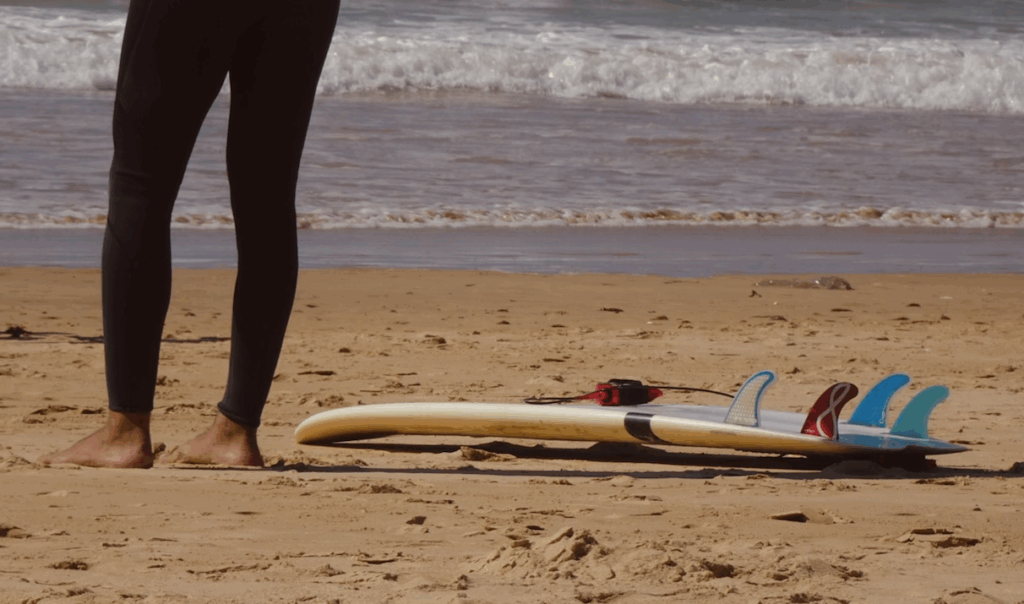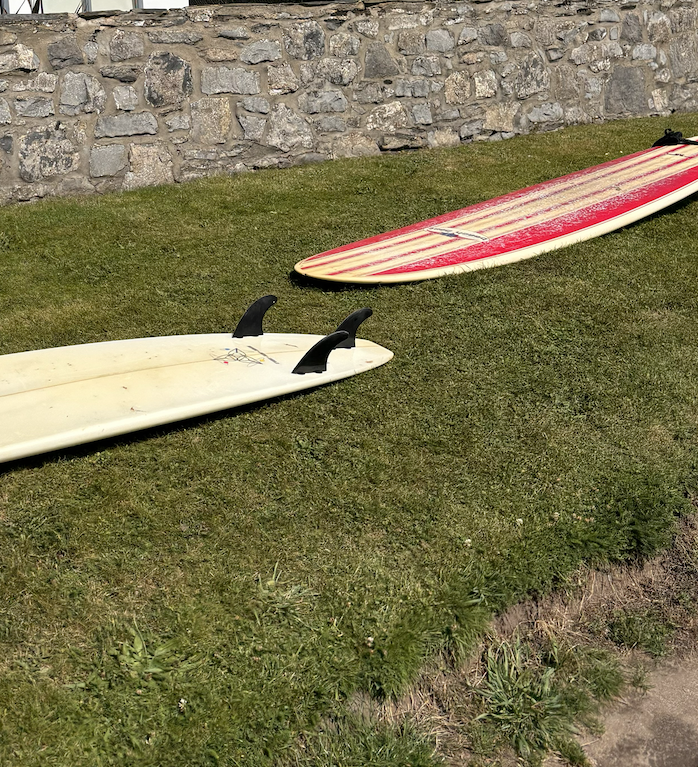Over the years, sounds have created global surf communities. Sidelines spoke to the world’s definitive expert on surf and music culture to understand how surfing communities are shaped not only by the waves, but the soundtrack.

Set against the backdrop of Cornwall’s golden coastline, Boardmasters festival attracts surf enthusiasts and music lovers from all over the world.
At the core of the festival is the World Qualifying Series event, in which surfers compete for a spot in the World Championship tour.
Over five busy days, the festival sprawls across Fistral Beach and Watergate Bay to immerse festival goers in the laid-back acoustic sessions and punk rock rhythms.
Whether it’s the soundtrack of the first waves at sunrise or of the evening bonfires, music is the heartbeat of surf culture and community.
Surfing is an artful dance with the ocean. Just like a dancer listens to the harmony of music, surfers listen to the waves, their fluid movements mirroring those of their natural surroundings.
No one understands this better than Timothy J. Cooley, a Professor of Ethnomusicology and Global International Studies at the University of California. He has travelled to the best surf spots around the world and spoken to some of the best surfers and musicians, turning his two biggest passions into a career.
“I’ve been a surfer since I was an adolescent. Then when I was 14 or 15 we moved inland and my surfing identity was curtailed somewhat because I didn’t have access to the ocean.
“But at that point I, already identified as a surfer so one of the things I did, I guess in protest, I just kept wearing my flip flops to school. I just got thick socks and tucked them in because it was very cold,” he says.
Cooley began his surfing journey in Florida before moving North to Virginia.
“What saved me in a way was, there was a huge high school with a huge music department, and I was also a musician – I was a guitarist and singer.”
While studying music, he maintained his passion for surfing, even surfing on Lake Michigan.
“I remember surfing there when the wind blew up waves and I remember once I saw another surfer on Lake Michigan.”
It was when Cooley became a music professor at Santa Barbara that he really started to notice the strength of surf communities.
“When I was carrying my mid-seventies surf board to the beach, more than once a university student would stop and say ‘wow, where did you get that board, where’s that from, maybe mid-seventies?’ And they would date it precisely within a year.
“So I realised that these surfers who were not alive when this board was made knew the material and cultural history of surfing. You know they weren’t learning that in books, they weren’t learning it from their professors but they knew it from the cultural history of the surfing community. So that gave me an idea about the strength of the surfing community here.”
The birthplace of surfing and its community can be traced back to Hawaii, where it is believed that surfing or ‘he’e nalu’ was introduced by the God of the sea (Kanaloa).
Surfing became a sacred practice that was deeply woven into the fabric of community life.
It had huge societal implications and a connection to people’s spirituality, so much so that their hierarchy correlated to the type of board they could use and wave they could ride.
Typically the smaller, easier waves were reserved for the chiefs or royalty and it was considered a violation, deserving severe penalties including death, if a common person rode that wave.
The importance of surfing even translated to their music.
Cooley says,:“Much of what we know about pre-revival surfing comes to us from Hawaiian legends and mele – the original surfing music.”
It appeared as a rhythmic chant, with each word ending in ‘i’.
A shift in surfing culture then occurred in the 1960s when the sport travelled over the Pacific Ocean to California.
Cooley says, “Things were happening that were connecting the idea of surfing with a popular cultural concept post World War Two.”

The state had seen huge advancements in technology and economic growth following the war and California dreamers had reimagined every element into a pop art infused haven.
“A lot of people had served and had been overseas in Hawaii and back to Southern California. Then in 1959 Hawaii became the 50th State.”
“Here in California, my dentist surfs, your lawyers surf, I’ve met some physicians who I’ve seen in clinics before when I’m in a line at surfing. You know it’s kind of like golf, it’s something that community leaders do which is more like a Hawaiian model so that was interesting to me.
“So just a few years later we have a thing called surf music and it’s identified with Southern California not Hawaii,” says Cooley
Characteristics then emerged of having a groovy, surf-themed title, smooth guitar playing, and a catchy tune, which Surfin’ U.S.A by The Beach Boys accomplished.
Not every surfer was a fan though.
Suddenly, the shared sounds that had once helped forge surf communities started to divide them.
Cooley says, “By the end of the sixties the music was considered fairly passé by some surfers.”
“Although in the seventies when I was surfing, I identified with the Beach Boys, when I started doing this research, I realised that there was actually a lot of resistance to this idea of surf music in the surfing community.
“If you were a surfer and a musician people would expect you to do that kind of thing, which is quite antique now. They claimed that the Beach Boys were stealing their culture and they didn’t even know how to surf,” says Cooley.
In the 1970s, surfing then underwent another transformation. The groovy instrumentals were replaced with harsher rock and punk styles, creating the surf punk genre.
This development created a cultural connection between surfing and skateboarding, a sport that was initially regarded as ‘sidewalk surfing’ in Southern California.
Since then surf music has continued to evolve with a revival in the 80s, the fusion of other styles and communities, and it now exists as a nostalgic genre with a contemporary influence.
The 21st century brought new tech advancements and with that, new ways to make music and new ways to build communities.
Many fans now exist purely online in communities forged through algorithms and surfers reach them by adding trending music to their videos.
Andrew Cotton, an award-winning professional big wave surfer, says, “I think for social media and watchful content, music is super important.”
“Recently I’ve been using more classical music on my videos and I think they fit really well. It’s not the thing you’d usually see on a surfing video, but I think it heightens the emotion.”
Events like Boardmasters, with their varied display of artists and music genres allow these communities to dance together.
This year, artists like Raye, the Kaiser Chiefs, Rizzle Kicks and Central Cee will provide the unifying music of the event.
For those who will be attending the festival and strolling into the various wetsuit-scented surf shops lined with boards of every size, shape and colour, they will hear more of what surfers listen to.
From the beginning, music has helped form the identity and rhythm of surfing communities, but like a runner’s connection to the track or a footballer’s to the ball, a surfer’s strongest bond is with the waves – that’s where the true music comes from.
“They have created waterproof earbuds but I don’t see them being used in surfing, which I’m glad about as the sounds of surfing are very nice.
“I think a lot of surfers don’t want to hear other sounds, they enjoy listening to the waves.”
For Cooley, despite his research and deep love and admiration of surf music, nothing will ever beat the symphony of the waves as they dance together and crash along the shoreline.



